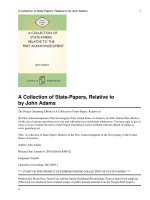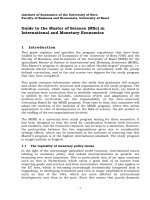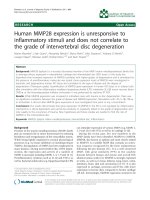knots groups and 3-manifolds papers dedicated to the memory of r h fox aug 1975
Bạn đang xem bản rút gọn của tài liệu. Xem và tải ngay bản đầy đủ của tài liệu tại đây (4.46 MB, 334 trang )
KNOTS, GROUPS,
AND
3-MANIFOLDS
Papers Dedicated
to
the Memory
of
R. H Fox
EDITED
BY
L.
P.
NEUWIRTH
UNIVERSITY
OF
TOKYO PRESS
PRINCETON, NEW JERSEY
1975
4 "lIvr
i~:ht
© 1975 by Princeton University Press
ALL RIGHTS RESERVED
Published in
Japan
exclusively
by
University
of
Tokyo
Press;
In other parts
of
the world by
Princeton University Press
Printed in the United States
of
America
hv
1'1
illl:clon University Press, Princeton,
New
Jersey
(.
I
il>r
"I
y
of
('ongn:ss
Cataloging
in
Publication
data
will
1>('
fOlllld
Oil
the last printed page
of
this book
CONTENTS
INTRODUCTION
BIBLIOGRAPHY,
RALPH
HARTZLER
FOX
Knots
and
Links
vii
viii
SYMMETRIC
FIBER
ED LINKS 3
by
Deborah
L.
Goldsmith
KNOT MODULES 25
by
Jerome
Levine
THE
THIRD HOMOTOPY
GROUP
OF
SOME
HIGHER
35
DIMENSIONAL KNOTS
by S.
J.
Lomonaco,
Jr.
OCTAHEDRAL
KNOT COVERS 47
by
Kenneth
A.
Perko,
Jr.
SOME KNOTS
SPANNED
BY MORE THAN ONE UNKNOTTED 51
SURFACE
OF
MINIMAL GENUS
by
H.
F.
Trotter
GROUPS
AND
MANIFOLDS
CHARACTERIZING
LINKS
63
by Wilbur Whitten
Group
Theory
HNN GROUPS
AND
GROUPS WITH
CENTRE
by
John
Cossey
and
N.
Smythe
QUOTIENTS
OF
THE
POWERS
OF
THE
AUGMENTATION
IDEAL
IN
A
GROUP
RING
by
John
R.
Stallings
KNOT-LIKE
GROUPS
by
Elvira
Rapaport
Strasser
3-Dimensional
Manifolds
87
101
119
ON
THE
EQUIVALENCE
OF
HEEGAARD
SPLITTINGS
OF
137
CLOSED,
ORIENTABLE
3-MANIFOLDS
by
Joan
S. Birman
BRANCHED
CYCLIC
COVERINGS
165
by
Sylvain
E. Cnpp!'ll ann
Julius
L.
Shaneson
vi
CONTENTS
ON
THE
3-DlMENSIONAL BRIESKORN MANIFOLDS M(p,
q,
r)
175
by
John
Milnor
SURGERY
ON
LINKS
AND
DOUBLE
BRANCHED COVERS
OF
227
OF
S3
by
Jose
M.
Montesinos
PLANAR
REGULAR
COVERINGS
OF
ORIENTABLE
261
CLOSED
SURF
ACES
by
C.
D.
Papakyriakopoulos
INFINITELY
DIVISIBLE
ELEMENTS
IN 3-MANIFOLD GROUPS 293
by
Peter
B.
Shalen
INTRODUCTION
The
influence
of
a
great
teacher
and
a
superb
mathematician
is
measured
by
his
published
work,
the
published
works
of
his
students,
and,
perhaps
foremost,
the
mathematical
environment
he
fostered
and
helped
to
maintain.
In
this
last
regard
Ralph
Fox's
life
was
particularly
striking:
the
tradition
of
topology
at
Princeton
owes
much
to
his
lively
and
highly
imaginative
presence.
Ralph
Fox
had
well
defined
tastes
in
mathematics.
Although
he
was
not
generally
sympathetic
toward
topo-
logical
abstractions,
when
questions
requiring
geometric
intuition
or
algebraic
manipulations
arose,
it
was
his
insights
and
guidance
that
stimulated
deepened
understanding
and
provoked
the
development
of
countless
theorems.
This
volume
is
a
most
appropriate
memorial
for
Ralph
Fox.
The
con-
tributors
are
his
friends,
colleagues,
and
students,
and
the
papers
lie
in
a
comfortable
neighborhood
of
his
strongest
interests.
Indeed,
all
the
papers
rely
on
his
work
either
directly,
by
citing
his
own
results
and
his
clarifications
of
the
work
of
others,
or
indirectly,
by
ac
know
ledging
his
gentle
guidance
ihto
and
through
the
corpus
of
mathematics.
The
reader
may
gain
an
appreciation
of
the
range
of
Fox's
own
work
from
the
following
bibliography
of
papers
published
during
the
thirty-six
years
of
his
mathematical
life.
L.
Neuwirth
PRINCETON,
NEW
JERSEY
OCTOBER
1974
BIBLIOGRAPHY,
RALPH
HARTZLER
FOX
(1913 -1973)
1936
(with R. B.
Kershner)
Transitive
properties
of
geodesics
on a
rational
polyhedron,
Duke
Math.
Jeur.
2, 147-150.
1940
On homotopy and
extension
of
mappings,
Proc. Nat.
Acad.
Sci.
U.S.A.
26,
26-28.
1941
Topological
invariants
of
the
Lusternik-Schnirelmann
type,
Lecture
in
Topology,
Univ. of Mich.
Press,
293-295.
On
the
Lusternik-Schnirelmann
category,
Ann.
of
Math.
(2),12,333-370.
Extension
of homeomorphisms
into
Euclidean
and
Hilbert
parallelotopes,
Duke
Math.
Jour.
8,
452-456.
1942
A
characterization
of
absolute
neighborhood
retracts,
Bull.
Amer. Math.
Soc.
48,
271-275.
1943
On homotopy
type
and
deformation
retracts,
Ann.
of
Math. (2)
44,
40-50.
On
the
deformation
retraction
of
some
function
spaces
associated
with
the
relative
homotopy
groups,
Ann.
of
Math. (2)
44,
51-56.
On
fibre
spaces,
I,
Bull.
Amer. Math.
Soc.,
49,
555-557.
On
fibre
spaces,
II,
Bull.
Amer. Math.
Soc.,
49,
733-735.
1945
On
topologies
for
function
spaces,
Bull.
Amer. Math.
Soc.,
5],
429-432.
Torus
homotopy
groups,
Proc. Nat.
Acad.
Sci.
U.S.A.,
31,
71-74.
BIBLIOGRAPHY,
RALPH
HARTZLER
FOX
(1913-1973)
ix
1947
On a problem
of
S. Ulam
concerning
Cartesian
products,
Fund. Math., 34,
278-287.
1948
On
the
imbedding
of
polyhedra
in
3-spaces,
Ann. of Math. (2)
19,
462-470.
Homotopy
groups
and
torus
homotopy
groups,
Ann. of Math. (2)
49,
471-510.
(with
Emil
Arlin)
Some
wild
cells
and
spheres
in
three-dimensional
space,
Ann. of Math., (2)
49,
979-990.
1949
A
remarkable
simple
closed
curve,
Ann.
of
Math., (2)
50,
264-265.
1950
On
the
total
curvature
of
some
tame
knots,
Ann. of Math., (2)
52,
258-260.
(with
William A.
Blankinship)
Remarks
on
certain
pathological
open
sub-
sets
of
3-space
and
their
fundamental
groups,
Proc. Amer. Math. Soc., 1,
618-624.
1951
(with
Richard
C.
Blanchfield)
Invariants
of
self-linking,
Ann. of Math. (2)
53,
556-564.
1952
Recent
development
of knot
theory
at
Princeton,
Proceedings of the
Inter-
nF.l.tional
Congress of Mathematicians,
Cambridge,
Mass.,
Vol. 2, 453-457,
Amer.
Math. Soc.,
Providence,
R. I.
On
Fenchp.l's
conjecture
about
F-groups,
Mat.
Tidsskr.
B.
1952,61-65.
On
the
complementary
domains
of a
certain
pair
of
inequivalent
knots,
Nederl. Akad. Wetensch. Proc. Ser.
A.
55-Indagationes Math., 14, 37-40.
1953
Free
differential
calculus,
I,
Derivation
in
the
free
group
ring,
Ann.
of
Math., (2)
57,
547-560.
1954
Free
differential
calculus,
II,
The
isomorphism
problem of
groups,
Ann.
of
Math., (2)
59,
196-210.
(with
Guillermo
Torres)
Dual
presentations
of
the
group of a knot, Ann. of
Math.,
(2)
59,
211-218.
1956
Free
differential
calculus,
III.
Subgroups
Ann.
of
Math., (2)
64,
407-419.
x
BIBLIOGRAPHY,
RALPH
HARTZLER
FOX
(1913-1973)
1957
Covering
spaces
with
singularities.
Algebraic
Geometry
and
Topology.
A
symposium.
Princeton
University
Press.
243-257.
1958
Congruence
classes
of
knots,
Osaka Math. Jour., 10, 37-41.
On
knots
whose
points
are
fixed
under
a
periodic
transformation
of
the
3-sphere,
Osaka Math. Jour., 10, 31-35.
(with
K.
T.
Chen
and R. G.
Lyndon)
Free
differential
calculus,
IV.
The
quotient
groups
of
the
lower
central
series,
Ann.
of
Math., (2)
68,81-95.
1960
Free
differential
calculus,
V.
The
Alexander
matrices
re-examined,
Ann.
of
Math., (2)
71,408-422.
The
homology
characters
of
the
cyclic
coverings
of
the
knots
of
genus
one,
Ann.
of
Math., (2)
71,
187-196.
(with
Hans
Debrunner)
A mildly
wild
imbedding
of
an
n-frame, Duke Math.
Jour.,
27,
425-429.
1962
"Construction
of
Simply
Connected
3-Manifolds."
Topology
of
3-Manifolds
and
Related
Topics,
Englewood
Cliffs,
Prentice-Hall,
213-216.
"A
Quick
Trip
Through
Knot
Theory."
Topology
of
3-Manifolds
and
Related
Topics,
Englewood
Cliffs,
Prentice-Hall,
120-167.
"Knots
and
Periodic
Transformations."
Topology
of
3-Manifolds
and
Related
Topics,
Englewood
Cliffs,
Prentice-Hall,
177-182.
"Some
Problems
in Knot
Theory."
Topology
of
3-Manifolds
and
Related
Topics,
Englewood
Cliffs,
Prentice-Hall,
168-176.
(with O. G.
Harrold)
"The
Wilder
Arcs."
Topology
of
3-Manifolds
and
Related
Topics,
Englewood
Cliffs,
Prentice-Hall,
184-187.
(with
L.
Neuwirth)
The
Braid
Groups,
Math. Scand., 10, 119-126.
1963
(with
R.
Crowell)
Introduction
to Knot Theory, New York, Ginn and
Company.
BIBLIOGRAPHY,
RALPH
HARTZLER
FOX
(1913-1973)
xi
1964
(with
N.
Smythe)
An
ideal
class
invariant
of
knots,
Proc. Am. Math.
Soc.,
15,707-709.
Solution
of problem
P79,
Canadian
Mathematical
Bulletin,
7,
623-626.
1966
Rolling,
Bull.
Am.
Math.
Soc.
(1)
72,
162-164.
(with
John
Milnor)
Singularities
of
2-spheres
in
4-space
and
cobordism
of
knots,
Osaka
Jour.
of
Math. 3, 257-267.
1967
Two
theorems
about
periodic
transformations
of
the
3-sphere,
Mich. Math.
Jour.,
11,331-334.
1968
Some
n-dimensional
manifolds
that
have
the
same
fundamental
group,
Mich. Math. Jour.,
15,187-189.
1969
A
refutation
of
the
article
"Institutional
Influences
in
the
Graduate
Training
of
Productive
Mathematicians."
Ann.
Math. Monthly,
76,
1968-70.
1970
Metacyclic
invariants
of
knots
and
links,
Can. Jour. Math., 22, 193-201.
1972
On
shape,
Fund. Math.,
71,47-71.
Knots and
Links
SYMMETRIC
FlEERED
LINKS
Deborah
L.
Goldsmith
O.
Introduction
The
main
points
of
this
paper
are
a
construction
for
fibered
links,
and
a
description
of
some
interplay
between
major
problems
in
the
topology
of
3-manifolds;
these
latter
are,
notably,
the
Smith problem
(can
a knot
be
the
fixed
point
set
of a
periodic
homeomorphism of S3),
the
problem of
which
knots
are
determined
by
their
complement
in
the
3-sphere,
and
whether
a s imply
connected
manifold
is
obtainable
from
S3
by
surgery
on
a knot.
There
are
three
sections.
In
the
first,
symmetry
of
links
is
defined,
and a method for
constructing
fibered
links
is
presented.
It
is
shown
how
this
method
can
sometimes
be
used
to
recognize
that
a
symmetric
link
is
fibered;
then
it
reveals
all
information
pertaining
to
the
fibration,
such
as
the
genus
of
the
fiber
and
the
monodromy. By
way
of
illustration,
an
analysis
is
made
of
the
figure-8 knot
and
the
Boromean
rings,
which,
it
turns
out,
are
symmetric
and
fibered,
and
related
to
each
other
in
an
interesting
way.
In
Section
II
it
is
explained
how
to
pass
back
and forth
between
dif-
ferent
ways
of
presenting
3-manifolds.
Finally,
the
material
developed
in
the
first
two
sections
is
used
to
establish
the
interconnections
referred
to
earlier.
It
is
proved
that
com-
pletely
symmetric
fibered
links
which
have
repeated
symmetries
of
order
2
(e.
g.,
the
figure-8
knot)
are
characterized
by
their
complement
in
the
3-sphere.
I would
like
to
thank
Louis
Kauffman
and
John
W.
Milnor for
conversa-
lions.
4
DEBORAH
L.
GOLDSMITH
I.
Symmetric
fibered
links
§l.
Links
with
rotational
symmetry
By
a
rotation
of
S3
we
mean
an
orientation
preserving
homeomorphism
of
S3
onto
itself
which
has
an
unknotted
simple
closed
curve
A for
fixed
point
set,
called
the
axis
of
the
rotation.
If
the
rotation
has
finite
period
n,
then
the
orbit
space
of
its
action
on S3
is
again
the
3-sphere,
and
the
projection
map
p:
S3
S3
to
the
orbit
space
is
the
n-fold
cyclic
branched
cover
of S3
along
peA).
An
oriented
link
L C S3
has
a
symmetry
of
order
n
if
there
is
a
rota-
tion
of
S3
with
period
n
and
axis
A,
where
An
L
~
ep,
which
leaves
L
invariant.
We
will
sometimes
refer
to
the
rotation
as
the
symmetry,
and
to
its
axis
as
the
axis
of
symmetry
of L.
The
oriented
link
L
c:
S3
is
said
to
be
completely
symmetric
relative
to
an
oriented
link
L
o
'
if
there
exists
a
sequence
of
oriented
links
L
o
'
L
1
,",
L
n
= L
beginning
with
L
o
and
ending
with
L
n
~
L,
such
that
for
each
i
1=
0,
the
link
L
i
has
a
symmetry
of
order
ni > 1
with
axis
of
symmetry
Ai
and
projection
Pi:
S3
S3
to
the
orbit
space
of
the
symmetry,
and
L
i
_
1
"'"
p/L
i
).
If
L
o
is
the
trivial
knot,
then
L
is
called
a
completely
symmetric
link.
The
number n
is
the
complexity
of
the
sequence.
Abusing
this
terminology,
we
will
sometimes
refer
to
a
completely
symmetric
link
L of
complexity
n
(relative
to
L
o
)
to
indi-
cate
the
existence
of
such
a
sequence
of
complexity
n.
Figure
1
depicts
a
completely
symmetric
link
L of
complexity
3,
having
a
symmetry
of
order
3.
{'~
~~cfdu~
C2
\\
~
~')YJ
L
J
L~
SYMMETRIC
FInER
ED
LINKS
5
§2.
Symmetric
fibered
links
An
oriented
link
L C S3
is
fibered
if
the
complement
S3 - L
is
a
surface
bundle
over
the
circle
whose
fiber
F
over
1
(SI
is
the
interior
of a
compact,
oriented
surface
F
with
JF
~
L.
Such
a
link
L
is
a
generalized
axis
for a
link
L'c
S3 - L
if
L'
intersects
each
fiber
of
the
bundle
S3 - L
transversely
in n
points.
In
the
classical
case
(which
this
generalizes)
a
link
L'c
R
3
is
said
to
have
the
z-axis
for
an
axis
if
each
component
L'i
has
a
parametrization
L'i(e)
by
which,
for
each
angle
00'
the
point
L'i(e
O
)
lies
inside
the
half-plane
e",
00
given
by
its
equation
in
polar
coordinates
for R
3
.
We
will
define
L
to
be
an
axis
for
L'C
S3
if
L
is
a
generalized
axis
for
L'
and
L
is
an
unknotted
simple
closed
curve.
We
wish
to
investigate
sufficient
conditions
under
which
symmetric
links
are
fibered.
LEMMA
1
(A
construction).
Let
L'
be
a
fibered
link
in
the
3-sphere
and
suppose
p:
S3
>
S3
is
a
branched
covering
of
S3
by
S3,
whose
branch
set
is
a
link
Be
S3 - L'.
l£
L'
is
a
generalized
axis
for
B,
then
L =
p-l(L')
is
a
fibered
link.
Proof.
The
complement
S3
-
L'
fibers
over
the
circle
with
fibers
F
s'
s (
SI,
the
interior
of
compact,
oriented
surfaces
F
s
such
that
JF
s
= L'.
Let
F
s
=
p-l
(F
s
)
be
the
inverse
image
of
the
surface
F
s
under
the
branched
covering
projection.
Then
aF
s
=
Land
F
s
-
L,
s (
SI,
is
a
locally
trivial
bundle
over
SI
by
virtue
of
the
homotopy
lifting
property
of
the
covering
space
p:
S3
-
(L
U P
-1
(B))
-,
S3
-
(L'U
B).
Thus
S3 - L
fibers
over
SI
with
fiber,
the
interior
of
the
surface
Fl'
REMARK. An
exact
calculation
of
genus
(F
1)
follows
easily
from
the
equation
X(F
1
_p-l(B))
=
nx(F1
-B)
for
the
Euler
characteristic
of
the
covering
space
F
1
-
p l(B)
.,
F
1
- B.
For
example,
if
p:
S3
>
S3
is
a
regular
branched
covering,
L
has
only
one
component
and
k
is
the
6
DEBORAH L.
GOLDSMITH
number of
points
in
the
intersection
B n F
1
of
B
with
the
surface
F
1
,
we
can
derive
the
inequality:
genus
(F
1
)
~
n
genus
(F
1
)
+
~
+
n(ki2~.
From
this
it
follows
that
if
k>
1,
or
genus
(F
1
)
>
0,
then
genus
(F
1
)
> 0
and
L
is
knotted.
Recall
that
a
completely
symmetric
link
L C S3
(relative
to
L
o
)
is
given
by a
sequence
of
links
L
o
'
L
1
,.··,
L
n
= L
such
that
for
each
i
1=
0,
the
link
L
i
has
a
symmetry
of
order
ni
with
axis
of
symmetry
Ai'
and
such
that
Pi:
S3
+
S3
is
the
projection
to
the
orbit
space
of
the
symmetry.
THEOREM 1.
Let
L C S3
be
a
completely
symmetric
link
relative
to
the
libered
link
L
o
'
defined
by
the
sequence
of
links
L
o
'
L
1
,.
, L
n
=
L.
If
for
each
i
I-
0,
the
projection
Pi(L
i
)
of
the
link
L
i
is
a
generalized
axis
for
the
projection
Pi(A
i
)
of
its
axis
of
symmetry,
then
L
is
a non-
trivial
fibered
link.
Proof.
Apply
Lemma 1
repeatedly
to
the
branched
coverings
Pi:
S3
+
S3
branched
alol'g
the
trivial
knot
Pi(A
i
)
having
Pi(L
i
)
"'"
L
i
_
1
for
general-
ized
axis.
The
completely
symmetric
links
L
which
are
obtained
from a
sequence
L
o
'
L
1
,.··,
L
n
= L
satisfying
the
conditions
of
the
theorem,
where
L
o
is
the
trivial
knot,
are
called
completely
symmetric
fibered
links.
EXAMPLES.
In
Figure
2
we
see
a proof
that
the
figure-8
knot
L
is
a
completely
symmetric
fibered
knot
of
complexity
1,
with
a
symmetry
of
order
2.
It
is
fibered
because
p(A)
is
the
braid
a2"
l
al
closed
about
the
axis
p(L).
The
shaded
disk
F
with
JF
=
La
intersects
p(A)
in
three
points;
hence
the
shaded
surface
F=
p-l(F),
which
is
the
closed
fiber
of
the
fibration
of S3 -
Lover
Sl,
is
the
2-fold
cyclic
branched
cover
of
the
disk
F
branching
along
the
points
F n p(A),
and
has
genus
1.
In
Figure
3, it
is
shown
that
the
Boromean
rings
L
is
a
completely
symmetric
fibered
link
of
complexity
1,
with
a
symmetry
of
order
3.
SYMMETRIC
FIBER
ED
LINKS
7
F
tJ~is
A
of
sr'",etnt
3-
fold 1p
,,'"
breuded
Covet'
f(L)
lL)
l~
l~
piAl@?)
f{LJ
lAlCf{(2
r{LJ
6)
4.xis
A
Fig.
2.
Fig.
3.
This
link
is
fibered
because
p(A)
is
the
braid
a
2
1
a
1
closed
about
the
axis
p(L).
The
surface
F=
p-l(F)
which
is
the
closed
fiber
of
the
fibration
of S3 -
Lover
SI
is
not
shaded,
but
is
precisely
the
surface
obtained
by
Seifert's
algorithm
(se~
f12]).
It
is
a
particular
3-fold
cyclic
brunched
cover
of
the
disk
F
(shaded)
branching
along
the
three
points
F n
p(A),
;1
nd
hus
v,enus
I.
8
friviA!
knot
DEBORAH
L.
GOLDSMITH
Bor(J/f7ean
r"",s
~
Cdinf"Jt.~
S3"""t.tric.
~W
lmk
Fig.
4.
Finally,
we
see
from
Figure
4
that
these
two
examples
are
special
cases
of
a
class
of
completely
symmetric
fibered
links
of
complexity
1
with
a
symmetry
of
order
n,
obtained
by
closing
the
braid
b
n
,
where
b
-1
= a
2
a
l
·
II.
Presentations
of
3-manifolds
There
are
three
well-known
constructions
for a
3-manifold
M:
1\1
may
be
obtained
from a
Heegaard
diagram,
or
as
the
result
of
branched
covering
or
performing
"surgery"
on
another
3-manifold.
A
specific
construction
may
be
called
a
presentation;
and
just
as
group
presentations
determine
the
group,
but
not
vice-versa,
so
M
has
many
Heegaard,
branched
covering
and
surgery
presentations
which
determine
it
up
to
homeomorphism.
Insight
is
gained
by
changing
from
one
to
another
of
the
three
types
of
presentations
for
M,
and
methods
for
doing
this
have
been
evolved
by
various
people;
in
particular,
given
a
Heegaard
diagram
for
M,
it
is
known
how
to
derive
a
surgery
presentation
((9])
and
in
some
cases,
how
to
present
M
as
a
double
branched
cover
of
S3
along
a
link
([2]).
This
section
deals
with
the
remaining
case,
that
of
relating
surgery
and
branched
covering
constructions.
§l.
The
operation
of
surgery
Let
C
be
a
closed,
oriented
I-dimensional
submanifold
of
the
oriented
3-manifold
M,
consisting
of
the
oriented
simple
closed
curves
c
l
,"',
ck'
An
oriented
3-manifold
N
is
said
to
be
obtained
from M
by
surgery
on
C
if
N
is
the
result
of
removing
the
interior
of
disjoint,
closed
tubular
SYMMETRIC
FIBER
ED
LINKS
9
neighborhoods
Ti
of
the
ci's
and
regluing
the
closed
neighborhoods
by
orientation
preserving
self-homeomorphisms
cPi:
aT
i
aT
i
of
their
boundary.
It
is
not
hard
to
see
that
N
is
determined
up
to
homeomorphism
by
the
homology
classes
of
the
image
curves
cPi(mi)
in
HI(aTi;
Z),
where
mi
is
a
meridian
on
aT
i
(i.e.,
m
i
is
an
oriented
simple
closed
curve
on
aT
i
which
s
pans
a
disk
in
T i
and
links
ci
with
linking
number
+1
in
T
i)'
If
Yi
is
the
homology
class
in
HI
(aT
i;
Z)
repre-
sented
by
cPi(m
i
),
then
let
M(C;YI'''''Yk)
denote
the
manifold
N
ob-
tained
according
to
the
above
surgery
procedure.
When
it
is
possible
to
find a
longitude
E
i
on
aT
i
(i.e.,
an
oriented
simple
closed
curve
on
aT
i
which
is
homologous
to
c
i
in
T i
and
links
ci
with
linking
number
zero
in
M),
then
Yi
will
usually
be
expressed
as
a
linear
combination
rmi + s E
i
, r, s
(Z,
of
these
two
generators
for
HI
(aT
i
;
Z),
where
the
symbols
m
i
and
C
i
serve
dually
to
denote
both
the
simple
closed
curve
and
its
homology
class.
An
easy
fact
is
that
for
a
knot
C in
the
homology
3-sphere
M,
M(C;
rm
+ s
E)
is
again
a homology
sphere
exactly
when
r = ± 1.
§2.
Surgery
on
the
trivial
knot
in
S3
An
important
feature
of
the
trivial
knot
C
c:
S3
is
that
any
3-manifold
S\C;
m+ kE), k
(Z,
obtained
from
S3
by
surgery
on C
is
again
S3.
To
see
this,
decompose
S3
into
two
solid
tori
sharing
a common
boundary,
the
tubular
neighborhood
T I of
C,
and
the
complementary
solid
torus
T
2'
Let
1>:
T2
T2
be
a homeomorphism
which
carries
m
to
the
curve
~
3 3
m
j-
k
E;
then
cP
extends
to
a homeomorphism
cP:
S
->
S
(C;,
+ k
E).
Now
suppose
B
c:
S3
is
some
link
disjoint
from
C.
The
link
Be
S3(C; m+
kE)"
is
generally
different
from
the
link
Be
S3.
Specifically,
B
is
transformed
by
the
surgery
to
its
inverse
image
cP-I(B)
under
the
identification
cP:
S3
S3(C; m+k
E).
The
alteration
may
be
described
in
the
following
way:
Let
B
be
transverse
to
some
cross-sectional
disk
of
T2
having
E
for
boundary.
Cut
S3 and B
open
along
this
disk,
and
label
the
two
10
DEBORAH
L.
GOLDSMITH
copies
the
negative
side
and
the
positive
side
of
the
disk,
according
as
the
meridian
m
enters
that
side
or
leaves
it.
Now
twist
the
negative
side
k
full
rotations
in
the
direction
of -
e,
and
reglue
it
to
the
positive
side.
The
resulting
link
is
<,6-1
(B).
For
example,
if B
is
the
n-stringed
braid
b
(B
n
closed
about
the
axis
C,
where
B
n
is
the
braid
group
on
n-strings,
and
if c
is
an
appropriate
generator
of
center
(B
n
),
then
Be
S3(C;
m+ke)
is
the
closed
braid
b·
c
k
.
Figure
5
illustrates
this
phenomenon.
In
Figure
6 it
is
shown
how
to
change
a
crossing
of a
link
B by
doing
surgery
on
an
unknotted
simple
closed
curve
C
in
the
complement
of
B.
Fig.
Sa.
Fig.
Sb.
Fig.
6.
SYMMETRIC
FIBER
ED
LINKS
11
83.
The
branched
covering
operation
For
our
purposes,
a map
f:
N
->
M
between
the
3-manifolds
Nand
M
is
a
branched
covering
map
with
branch
set
Be:
M,
if
there
are
triangula-
tions
of
Nand
M for
which
f
is
a
simplicial
map
where
no
simplex
is
mapped
degenerately
by f,
and
if
B
is
a
pure
I-dimensional
subcomplex
of
M
such
that
the
restriction
fl
N_f-
1
(B):
N_f-
1
(B)
,M-B
is
a
covering
(see
[5]).
The
foldedness
of
the
branched
covering
f
is
defined
to
be
the
index
of
the
covering
fiN
-
f-
1
(B).
We
will
only
consider
the
case
where
the
branch
set
Be
M
is
a
I-dimensional
submanifold,
and
the
folded
ness
of
f
is
a
finite
number,
n.
Then
f
and
N
are
determined
by
a
representation
77
1
(M-B).
S(n)
of
the
fundamental
group
of
the
complement
of B in M
to
the
symmetric
group on n
numbers
(see
[4]).
Given
this
representation,
the
manifold
N
is
constructed
by
forming
the
covering
space
f':
N'
• M - B
corresponding
to
the
subgroup
of
77
1
(M-B)
represented
onto
permutations
which
fix
1,
und
then
completing
to
f:
N
->
M
by
filling
in
the
tubular
neighborhood
of
B
and
extending
f'
to
f.
A
regular
branched
covering
is
one
for
which
f':
N'
) M - B
is
a
regu-
lar
covering,
or in
other
words,
one
for
which
the
subgroup
of
77
1
(M-B)
in
question
is
normal.
Among
these
are
the
cyclic
branched
coverings,
given
by
representations
77
1
(M-B)
->
Zn
onto
the
cyclic
group
of
order
n,
such
that
the
projection
f:
N -> M
is
one-to-one
over
the
branch
set.
Since
I.
n
is
abelian,
these
all
factor
through
the
first
homology
group
77
1
(M-B)
-> HI
(M-Bj
Z)
-,
Zn
.
Does
there
always
exist
an
n-fold
cyclic
branched
covering
N -> M
with
a
given
branch
set
Be
M?
The
simplest
case
to
consider
is
the
one
in
which
M
is
a
homology
3-sphere.
Here
HI
(M-B;
Z)
~
Z
Ell
Z
Ell
•
Ell
Z
is
generated
by
meridians
lying
on
tubes
about
each
of
the
components
of
12
DEBORAH
L.
GOLDSMITH
the
branch
set.
Clearly
all
representations
of
HI
(M-B;
Z)
onto
Zn
which
come
from
cyclic
branched
coverings
are
obtained
by
linearly
ex-
tending
arbitrary
assignments
of
these
meridians
to
± 1.
This
guarantees
the
existence
of many
n-fold
cyclic
branched
coverings
of M
branched
along
B,
except
in
the
case
n =
2,
or in
case
B
has
one
component,
when
there
is
only
one.
Should
M not
be
a homology
sphere,
an
n-fold
cyclic
covering
with
branch
set
B
will
exist
if
each
component
of
B
belongs
to
the
n-torsion
of HI
(M;
Z),
but
this
condition
is
not
always
necessary.
§4. Commuting
the
two
operations
If
one
has
in
hand
a
branched
covering
space,
and
a
surgery
to
be
per-
formed on
the
base
manifold,
one
may
ask
whether
the
surgery
can
be
lifted
to
the
covering
manifold
in
such
a
way
that
the
surgered
manifold
upstairs
naturally
branched
covers
the
surgered
manifold
downstairs.
The
answer
to
this
is
very
interesting,
because
it
shows
one
how
to
change
the
order
in
which
the
two
operations
are
performed,
without
changing
the
resulting
3-manifold.
Let
f:
N
->
M
be
an
n-fold
branched
covering
of
the
oriented
3-manifold
M
along
Be
M
given
by a
representation
ep:"1
(M-B)
S(n),
and
let
M(C;
YI
"",
Yk)
be
obtained
from M by
surgery
on C C
M,
where
C n B =
ep.
Note
that
the
manifold
N -
f-I
(C)
is
a
branched
covering
space
of
M- C
branched
along
B C M-
C,
and
is
given
by
the
representa-
tion
where
i:"1
(M
- [C U
Bj)
"I
(M-B)
is
induced
by
inclusion.
Now
let
the
components
of
f-I(T
i
)
be
the
solid
tori
T
ij
, j =
1,·
,n
i
,
i=l,···,k;
on
the
boundary
of
each
tube
choose
a
single
oriented,
simple
closed
curve
in
the
inverse
image
of a
representative
of Yi' and
denote
its
homology
class
in
HI
(aT
ij;
Z)
by
Yij'
SYMMETRIC
FIDERED
LINKS
13
THEOREM 2.
Suppose
Yi
,"',
Yi
are
precisely
the
classes
among
1 I'
YI
,''',
Yk
which
have
a
representative
all
of
whose
lifts
are
closed
curves;
I'
let
B'
= C - U
c·.
Then
f:
N
-,
M
induces
a
branched
covering
j = 1 Ij
of
the
surgered
manifolds,
branched
along
BUB'
C M(C;
YI'''',
Yk)'
The
associated
representation
is
r/>':
77
1
(M(C;
YI
,''',
Yk)
- [B U
B'])
Sen),
defined
by
the
commutative
diagram
and
off
of
a tubular
neighborhood
f-
I
(UT.)
of
the
surgered
set,
the
maps
1
f
and
f'
agree.
Proof. One
need
only
observe
that
the
representation
r/>
does
indeed
factor
through
77
1
(M(C;
YI
,"',
Yk)-lB
U
B'])
because
of
the
hypothesis
that
there
exist
representatives
of
Yi
,"',
Yi
all
of
whose
lifts
are
closed
1
I'
curves.
The
meaning
of
this
theorem
should
be
made
apparent
by
what
follows.
EXAMPLE.
It
is
known
that
the
dodecahedral
space
is
obtained
from
S3
by
surgery
on
the
trefoil
knot
K;
in
fact,
it
is
the
manifold S3(K;
m-
n.
We
will
use
this
to
conclude
that
it
is
also
the
3-fold
cyclic
branched
cover
of S3
along
the
(2,5)
torus
knot,
as
well
as
the
2-fold
cyclic
branched
cover
of
S3
along
the
(3,5)
torus
knot
(see
[6]).
These
pre-
sentations
are
probably
familiar
to
those
who
like
to
think
of
this
homology
sphere
as
the
intersection
of
the
algebraic
variety
IXfC
3
:xi+xi+x~=OI
with
the
3-sphere
IXfC
3
: Ixl
~
11.
According
to
Figure
7,
the
trefoil
knot K
is
the
inverse
image
of
the
circle
C
under
the
3-fold
cyclic
hr;lllched
cover
of S3
along
the
trivial
14
DEBORAH
L.
GOLDSMITH
knot B. By
Theorem
2,
S3(K;
m-£)
is
the
3-fold
cyclic
branched
cover
of
S3(C;
m-3£)
branched
along
Be
S3(C;
m-3£).
Since
C
is
the
trivial
knot,
S3(C;
m-3£)
is
the
3-sphere,
and
Be
S3(C;
m-3£)
is
the
(2,5)
torus
knot,
as
in
Figure
Sa.
We
deduce
that
the
dodecahedral
space
is
the
3-fold
cyclic
branched
cover
of
S3
along
the
(2,5)
torus
knot.
A
similar
argument
is
applied
to
Figure
8,
in
which
the
trefoil
knot
is
depicted
as
the
inverse
image
of a
circle
C
under
the
double
branched
cover
of
S3
along
the
trivial
knot B. By
Theorem
2,
the
space
S3(K;m_£)
is
then
the
2-fold
cyclic
branched
cover
of
S3(C;m-2£)
along
Be
S3(C;
m-2£),
which
according
to
Figure
Sb
is
the
(3,5)
torus
3-foId
c~cllt
lp
bl'a.rK-hed
c.~e
elF
S~
a./oT19
B
B
c
Fig.
7.
c
Fig.
8.
SYMMETRIC
FIBER
ED
LINKS
15
knot.
Hence
the
dodecahedral
space
is
the
2-fold
cyclic
branched
cover
of S3
along
the
(3,5)
torus
knot.
The
following
definition
seems
natural
at
this
point:
DEFINITION.
Let
L
be
a
link
in a
3-manifold
M
which
is
left
invariant
by
the
action
of
a
group
G on
M.
Then
any
surgery
M(L;Yl,""Yk)
in
which
the
collection
IY
1'"''
Ykl
of homology
classes
is
left
invariant
by
G,
is
said
to
be
equivariant
with
respect
to
G.
The
manifold
obtained
by
equivariant
surgery
naturally
inherits
the
action
of
the
group G.
THEOREM
3 (An
algorithm).
Every
n-fold
cyclic
branched
cover
of
S3
branched
along
a
knot
K
may
be
obtained
from S3
by
equivariant
surgery
on
a
link
L
with
a
symmetry
of
order
n.
Proof.
The
algorithm
proceeds
as
follows.
Step
1.
Choose
a knot
projection
for
K.
In
the
projection
encircle
the
crossings
which,
if
simultaneously
reversed,
cause
K
to
become
the
trivial
knot
K'.
Step
2.
Lift
these
disjoint
circles
into
the
complement
S3 - K
of
the
knot,
so
that
each
one
has
linking
number
zero
with
K.
Step
3.
Reverse
the
encircled
crossings.
Then
orient
each
curve
ci
so
that
the
result
of
the
surgery
S3(ci;
m +
P.)
is
to
reverse
that
crossing
back
to
its
original
position
(see
Figure
6).
k
Step
4.
Let
C = . U c
i
be
the
union
of
the
oriented
circles
in S3- K',
3 3
1=1
3
:md
let
p:
S
S
be
the
n-fold
cyclic
branched
cover
of
S
along
the
trivial
knot K'.
Then
if
L =
p-l(C),
it
follows
from
Theorem
2
that
the
n-fold
cyclic
branched
cover
of S3
along
K
is
the
manifold
S3(L;rlml+rl,
·,rkmk+rk)
obtained
from
S3
by
equivariant
surgery
on
the
link
L,
which
has
a
symmetry
of
order
n.
Ex
AMPLE
(Another
presentation
of
the
dodecahedral
space).
In
Figure
9,
I(,t
p:
S3 >
S3
be
the
S-fold
eye
I i(' bra
nehed
cover
of S3 a
long
the
16
Step
I.
DEBORAH
L.
GOLDSMITH
step.:!.
K
K
Fig.
9.
1<'
~~
C
trivial
knot
K'.
Then
if
L
~
p-I(C)
as
in
step
4
of
Figure
9,
the
5-fold
cyclic
branched
cover
of
S3
along
the
(2,3)
torus
knot K
is
the
mani-
fold
S3(L;m
I
-rl'·
,ms-r
s
)
obtained
from
S3
by
equivariant
surgery
on
the
link
L.
III.
Applications
We
will
now
derive
properties
of
the
special
knots
constructed
in
Section
I.
Recall
that
a
knot
K
is
characterized
by
its
complement
if
no
surgery
S3(K; m+ k r), k
(Z
and
k
-t
0,
is
again
S3. A
knot
K
is
said
to
have
property
P
if
and
only
if no
surgery
S3(K; m + kP), k
(Z
and
SYMMETRIC
FIBERED
LINKS
k
-J-
0,
is
a
simply
connected
manifold.
A
fake
3-sphere
is
a homotopy
3-sphere
which
is
not
homeomorphic
to
S3.
17
THEOREM
4.
Let
K
be
a
completely
symmetric
fibered
knot
defined
by
the
sequence
of
knots
K
o
'
K
1
,"',
K
n
=
K,
such
that
each
K
i
, i
-J-
0,
is
symmetric
of
order
ni
=
2.
Then
K
is
characterized
by
its
complement.
THEOREM
5.
Let
K
be
a
completely
symmetric
fibered
knot
of
com-
plexity
1,
defined
by
the
sequence
K
o
'
K
1
= K,
where
K
is
symmetric
of
order n
1
=
n.
If
K
is
not
characterized
by
its
complement,
then
there
;s
a
transformation
of
S3
which
is
periodic
of
period
n,
having
knotted
fixed
point
set.
If
a
fake
3-sphere
is
obtained
from
S3
by
surgery
on
K,
then
there
is
a
periodic
transformation
of
this
homotopy
sphere
of
period
n,
having
knotted
fixed
point
set.
THEOREM
6.
Let
K
be
a
completely
symmetric
fibered
knot.
Then
if
K
does
not
have
property
P,
there
exists
a
non-trivial
knot
K'(
S3
such
that
for
some
n>
1,
the
n-fold
cyclic
branched
cover
of
S3
hranched
along
K'
is
simply
connected.
It
should
be
pointed
out
that
the
property
of a
knot
being
characterized
by
its
complement
is
considerably
weaker
than
property
P.
For
example,
it
is
immediate
from
Theorem
4
that
the
figure-8
knot
is
characterized
by
its
complement,
while
the
proof
that
it
has
property
P
is
known
to
be
difficult
(see
f71).
The
following
lemmas
will
be
used
to
prove
Theorems
4-6.
LEMMA
2.
The
special
genus
of
the
torus
link
of
type
(n,
nk),
k
-J-
0,
IS
hounded
below
by









